

Full-day country walks in
SE England and beyond
Cambridge to Trumpington
Click on the image below to access
the full map on plotaroute
Distance: 5.9 miles.
Time without long breaks: 3 1/2 hours, plus time for lunch/pubs.
Terrain: Easy. Some areas liable to flooding in winter months.
How to get there and back: Train to Cambridge. There are frequent buses from Trumpington back to the station and centre of the city.
Pubs: The Orchard at Grantchester (a licensed tearoom) is not to be missed. The village also has the Red Lion and the more modern Rupert Brooke. There are a number of pubs in Trumpington including a gastro pub/restaurant, the Sole & Duck. Or just head back into Cambridge (the Petersfield area near the station has many great pubs to choose from).
More information: The start of the walk takes you through Cambridge University Botanic Garden, which charges a fee for entry. It's open most of the year from 10am. Check the website for details.
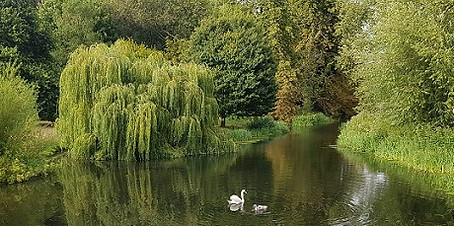
Similar to walk 28 near Oxford, this route is short enough to be part of a day trip or a prelude to a night out in the city (trains go from Kings Cross, St Pancras and Liverpool Street and run back late), The walk takes you through the botanic gardens and then follows a route familiar to many Cambridge alumni, along the River Cam through bucolic Grantchester Meadows and the village of Grantchester itself, once home to the poet Rupert Brooke (see below). His former residence is next door to the celebrated Orchard tea gardens. Apart from Brooke, there are also associations with Lord Byron and the walk includes a visit to Byron's Pool nature reserve, before ending in the suburb of Trumpington, where there are easy links back to the city.
Leave the station via the main exit and walk up Station Road straight ahead of you. When you reach the main road, cross over towards the statue of the soldier. Here you will find the entrance to Cambridge University Botanic Garden. The garden is a beautiful and fascinating place to explore before the start of the walk and is home to over 8,000 species of plants, some housed in tropical hot glasshouses. It also includes (allegedly) the descendent of the apple tree that inspired Isaac Newton to formulate the theory of gravity.

Along with the adjacent common, Sheep's Green, the fen is grazed by animals and can become flooded in winter. Follow the path down the field and then bear right towards Sheep's Green Bridge. Just before you reach the bridge, there is a gate on your left. Go through it to reach Hodson's Folly, a small building in a classical style. It was built by a butler of Pembroke College in the late 19th century so he could keep an eye on his daughters while they were bathing. It is still a popular spot for swimmers today. Return to the path and cross over the bridge and keep straight ahead before crossing over another smaller metal bridge.
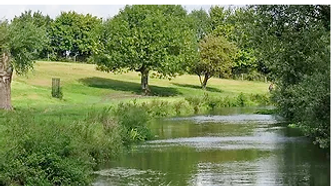
About 150m further on you reach Grantchester Meadows themselves. Turn left to walk down to the river and then follow its course along the path. These tranquil water meadows have many literary and cultural connections. Rupert Brooke and Virigina Woolf went swimming together here. They are also celebrated in the poem Watercolour of Grantchester Meadows by Sylvia Plath and Grantchester Meadows, an early song by Pink Floyd. In 2021, Kings College (which owns the land) controversially announced that swimming would be banned due to a safety concerns, ending the long tradition of river bathing here.


The church clock is mentioned in the famous ending couplet of Brooke's poem Old Vicarage, Grantchester (see below). Grantchester is said to have the highest concentration of Nobel Prize winners, due to its proximity to Cambridge and being a popular place for wealthy dons to retire. The churchyard contains the graves of many scientists and academics, as well as the film-maker and Mary Poppins director Robert Stevenson. Just past the church. you will come to Spring Lane on your left and a sign for The Orchard. Turn right at the top of the lane to reach the tea rooms.

Leave the tearooms via the main entrance (passing the currently closed Rupert Brooke museum on the right) to emerge at Mill Way. Just to the right of the entrance is Orchard House itself. Rupert Brooke moved here in 1909 and it formed the backdrop for a group of intellectual friends who used to meet there. In addition to Woolf, Russell and Wittgenstein, the group also included E. M. Forster, Maynard Keynes and Augustus John. Brooke described Grantchester as his arcadia. He would often wander barefoot through the village, while apparently living off little but fruit and honey, and would commute to Cambridge by canoe.

About 300m along the road you come to another bridge, this one over the River Granta. Just on the other side, on the right, is a metal swing gate. Go through this gate which leads to Byron's Pool nature reserve, where if you are lucky you may spot kingfishers and woodpeckers. The path heads away from the river by an information board. Bear right when it meets a picnic area, following its edge, and then turn right to reach the riverside path. When you get to the weir, cross over the wooden bridge to reach the pool where Lord Byron apparently used to bathe. Further on you will come to a wooden memorial bench inscribed 'Forever missed, Forever loved'. From here you can turn back inland from the river along a path that goes through the woods.

After passing the church on your right, you will come to a junction, with Anstey Hall (a country house, now a hotel) visible to your right. Bear left into Church Lane to reach the Lord Byron Inn. You can either continue up Church Lane past the grounds of Trumpington Hall to reach the Alpha Terrace bus stop next to the Sole & Duck and opposite the Green Man (another pub, Hudson's Ale House, is a little way back down the road). Alternatively, head down Maris Lane past Anstey Hall. At the bottom, turn left for the Anstey Way bus stop which has much more frequent buses to Cambridge and the station. If you need to, you can check the bus times here.
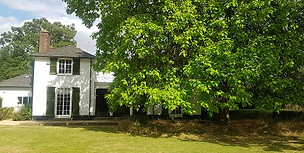
Leave the botanic gardens by the north-west exit. After going through the exit gate, turn right and then left into Brookside. To the left are some private gardens, through which runs Hobson's Brook (a watercourse built in the 17th century to supply the city with fresh drinking water). Turn left when you reach the Hobson's Conduit monument. Then cross over Trumpington Road, turn left, and take a right into the Fen Causeway. To your left are the grounds of the Leys School, a private boarding school. After you pass the school, take the gate on your left into the open space of Coe Fen.

Immediately after the bridge, take a left with a car park on your right. Follow the sign for the riverside walk, going through a swing gate into Paradise Nature Reserve, home to weeping willows, butterbur and the musk beetle. Follow this path, part of which runs along boardwalks, as it goes along the river. At the end of the nature reserve, it turns inland. You emerge at a wooden gate opposite a house with a wooden fence. Turn left and follow the lane round and then turn left into a road called Grantchester Meadows. After the houses end, there are some tennis courts on your right. You will see a metal gate ahead. Take the path to the left of the gate.
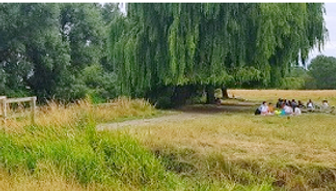
After following the riverbank for just under a mile, crossing over a series of small bridges and going through a metal swing gate, you will see a large gate ahead of you, with a smaller gate near it, and a house up on your right. Turn right before you reach the gates and follow the track towards the house, going through a wooden gate which leads onto a road. On your right you reach the Red Lion pub. There used to be another pub further up at the junction, the Green Man, but it now seems to have closed. If you turn right into the High Street, the Cambridge Gin Distillery is on your left (good for take-outs!). To continue the walk, thou,h you need to head the other way down towards the church.

The Orchard Tea Garden has an interesting history (see here). First planted in 1868, some students chose to sit in the orchard for tea rather than the gardens of Orchard House. It soon became a bit of a Cambridge institution, with scholars cycling, walking or punting from the city to get here. As well as Brooke and Woolf, visitors included Bertrand Russell, Ludwig Wittgenstein, Alan Turing and Stephen Hawking. It was saved from developers in the early 1990s by Robin Callan, who described it as 'God's little acre'. He was determined to keep The Orchard in its traditional guise of old deckchairs and dark-painted tables. As well as tea, it serves meals and alcoholic drinks, including, of course, cider.

Turn back down Mill Way, walking back past the tearooms. The next house, at a bend in the road, is The Old Vicarage, where Brooke also stayed and which was celebrated in one of his best-known poems. There is a statue to him in the entrance of the house, which is now owned by Jeffrey and Mary Archer. Just past the house, there is a footpath on the left. Take this path, which runs between two walls before reaching a mill pond, where you will see weeping willows, a 'Monet' bridge, and a statue of a horse. On your right is Mill House, where Betrand Russell lived for ten years, and ahead of you, on the other side of the bridge, Grantchester Mill. When you reach the road, turn left and cross over the bridge.
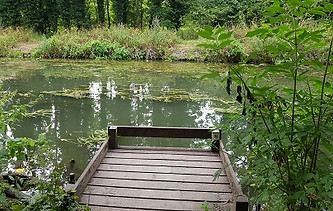
After about 400m, you will see an exit from the woods on your right that leads to Trumpington Meadows Country Park, a vast expanse of grassland managed by the Wildlife Trust. In 2011 archaeologists discovered a rare Anglo-Saxon bed burial here – a teenage girl buried lying on a wooden bed, with an ornate gold cross around her neck Take the broad track ahead and then turn left. Then follow the track that bears right leading towards the houses. Walk up alongside the houses towards a large black building ahead, which is the Wildlife Trust offices. The path emerges at Grantchester Road. Turn right and follow the road into Trumpington village.
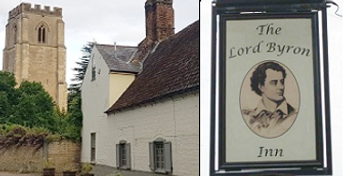

Rupert Brooke is often referred to as a war poet, although the sonnets he wrote in his 1914 collection did not describe his wartime experiences (he didn't see active service until 1915) – they were an expression of his patriotic idealism. Brooke believed the war would give young men a sense of purpose and an opportunity for noble sacrifice. This is reflected in his most famous lines (from The Soldier) – 'If I should die, think only this of me: / That there's some corner of a foreign field / That is for ever England.' Educated at Rugby School, he had a typical privileged upbringing of the time. He studied classics at King's College, where, famed for his foppish good looks, he was a popular figure, falling in with literary circles including the Bloomsbury Group and the Dymock Set – although his pre-war poetry is aligned with the Georgian poets and characterised by pastoral themes.
Sometimes considered naive and unsophisticated, his popular work includes The Old Vicarage, Grantchester, a paean to his sometime home. It ends with the lines: 'Stands the church clock at ten to three? / And is there honey still for tea?' The poem was written in Berlin in 1912, when Brooke was recovering from a breakdown caused in part by his complicated sexual relationships (with both men and women). At Cambridge, Brooke was part of the 'neo-Pagan set', which celebrated activities such as sleeping out in the open air and naked swimming. Virginia Woolf recounted that she went moonlight skinny dipping with Brooke in a pool – possibly Byron's Pool, which you visit on this walk. Brooke died of sepsis on a Royal Navy vessel in the Aegean in 1915 at the age of 27. He is buried in an olive grove on the island of Skyros, in a corner of the world associated with Lord Byron, who died in Greece from a fever while fighting in the Greek War of Independence. In his book The Neo-Pagans, writer Paul Delany muses: 'Now another Cambridge poet, who had loved to swim in Byron's Pool, had shared Byron's fate.' KB
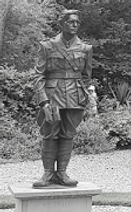
Walks by County
Listed by the most traversed
county for each route
Berkshire
Buckinghamshire
Henley circular
Pr. Risborough-Wendover
Tring circular
Tring-Leighton Buzzard
Cambridgeshire
Cambridge-Trumpington
Whittlesford-Wandlebury
Derbyshire
Edale-Hope
Dorset
Corfe Castle-W. Matravers
East Sussex
Ashdown Forest
Berwick circular
Berwick-Seaford
Cuckmere Haven-E'bourne
Forest Row-Eridge
Glynde-Berwick
Glynde-Seven Sisters
Isfield-Lewes
Lewes circular 1
Lewes circular 2
Lewes-Hassocks
Lewes-Rottingdean
Plumpton-Hassocks
Rye-Three Oaks
Gloucestershire
Kingham circular
Toddington-Cleeve Hill
Hertfordshire
Codicote-St Albans
Odsey-Royston
Kent
Oxfordshire
Surrey
West Sussex
Bramber-Amberley
Steyning circular
West Yorkshire
Haworth-Hebden Bridge
Wiltshire
Avebury circular
